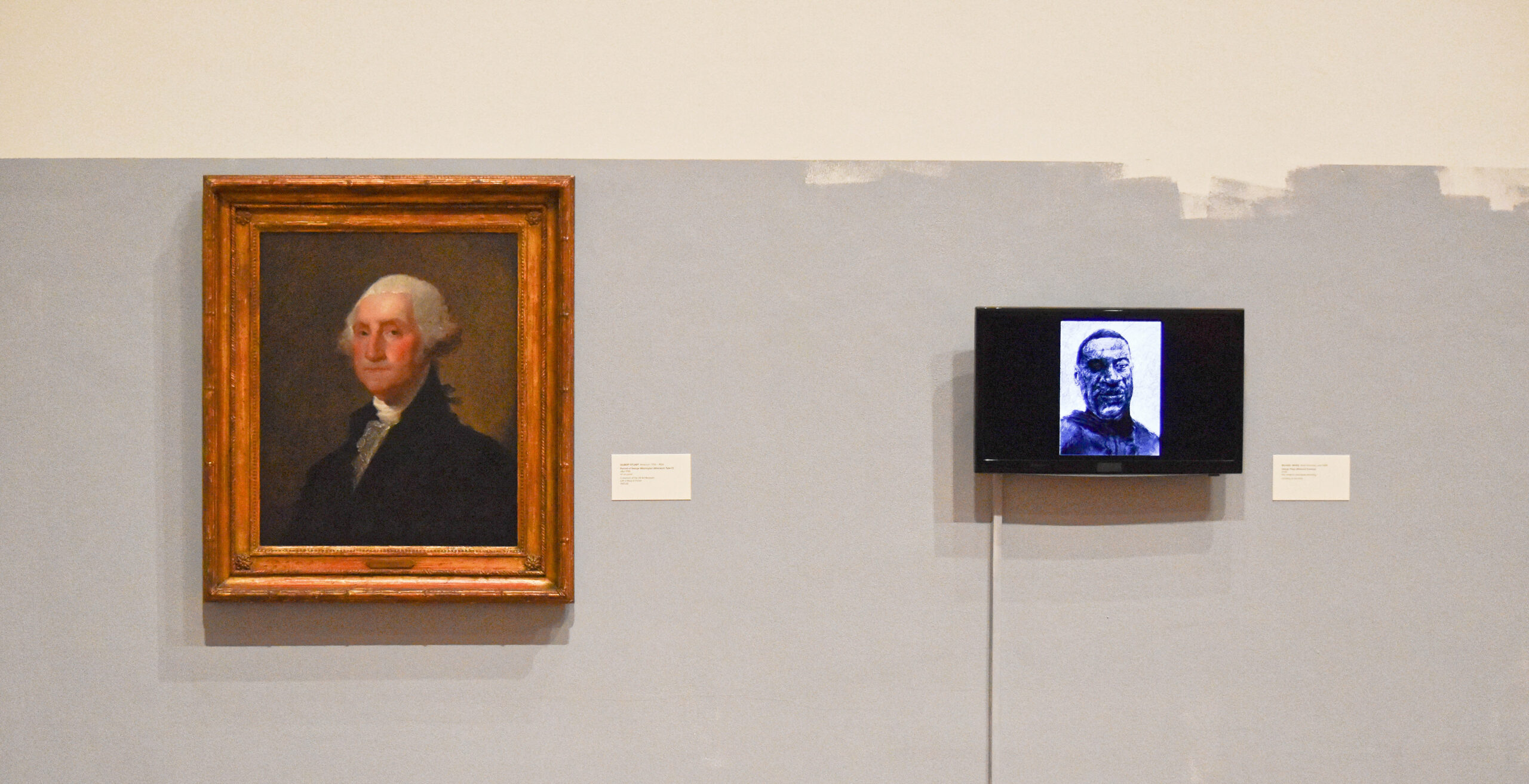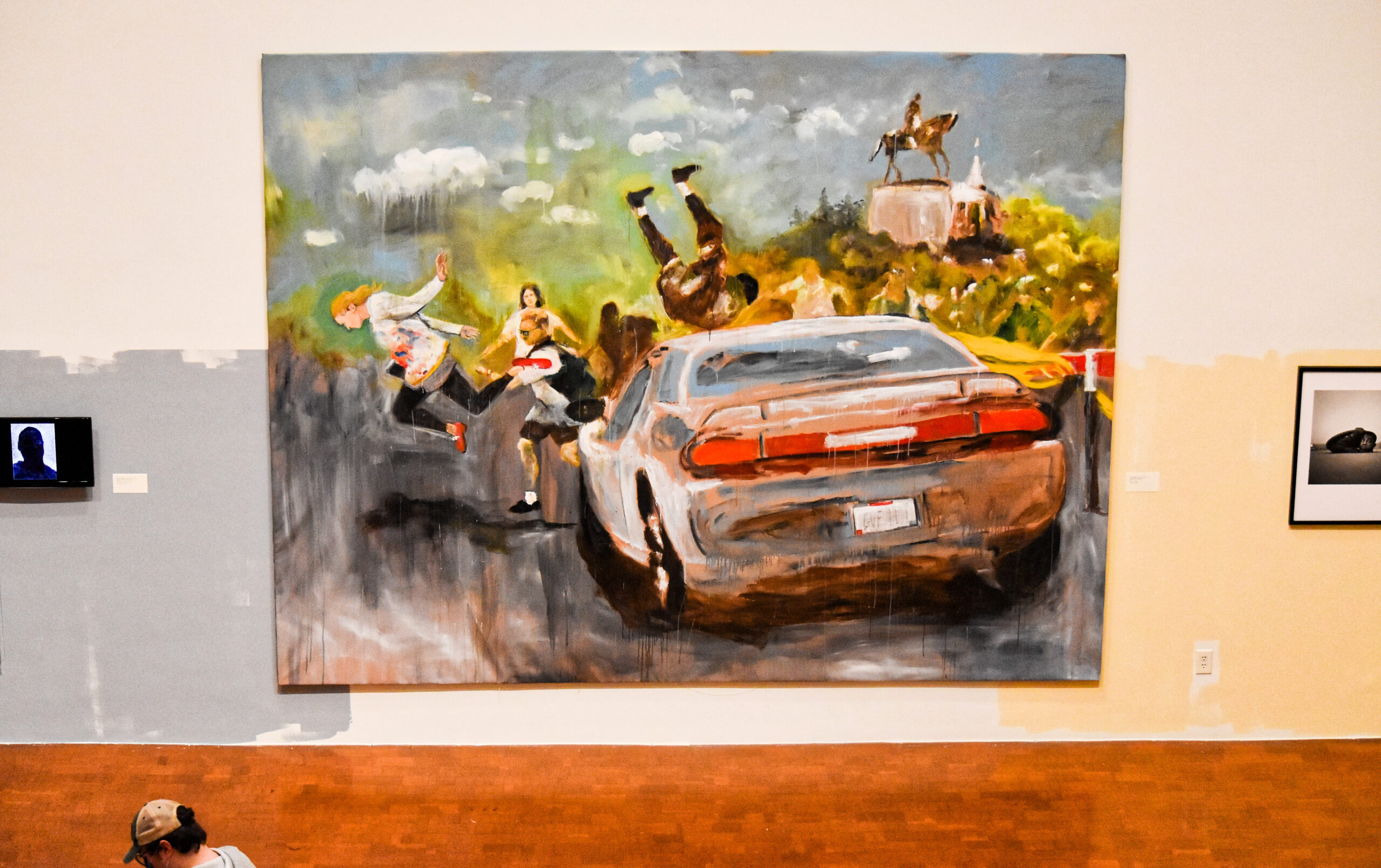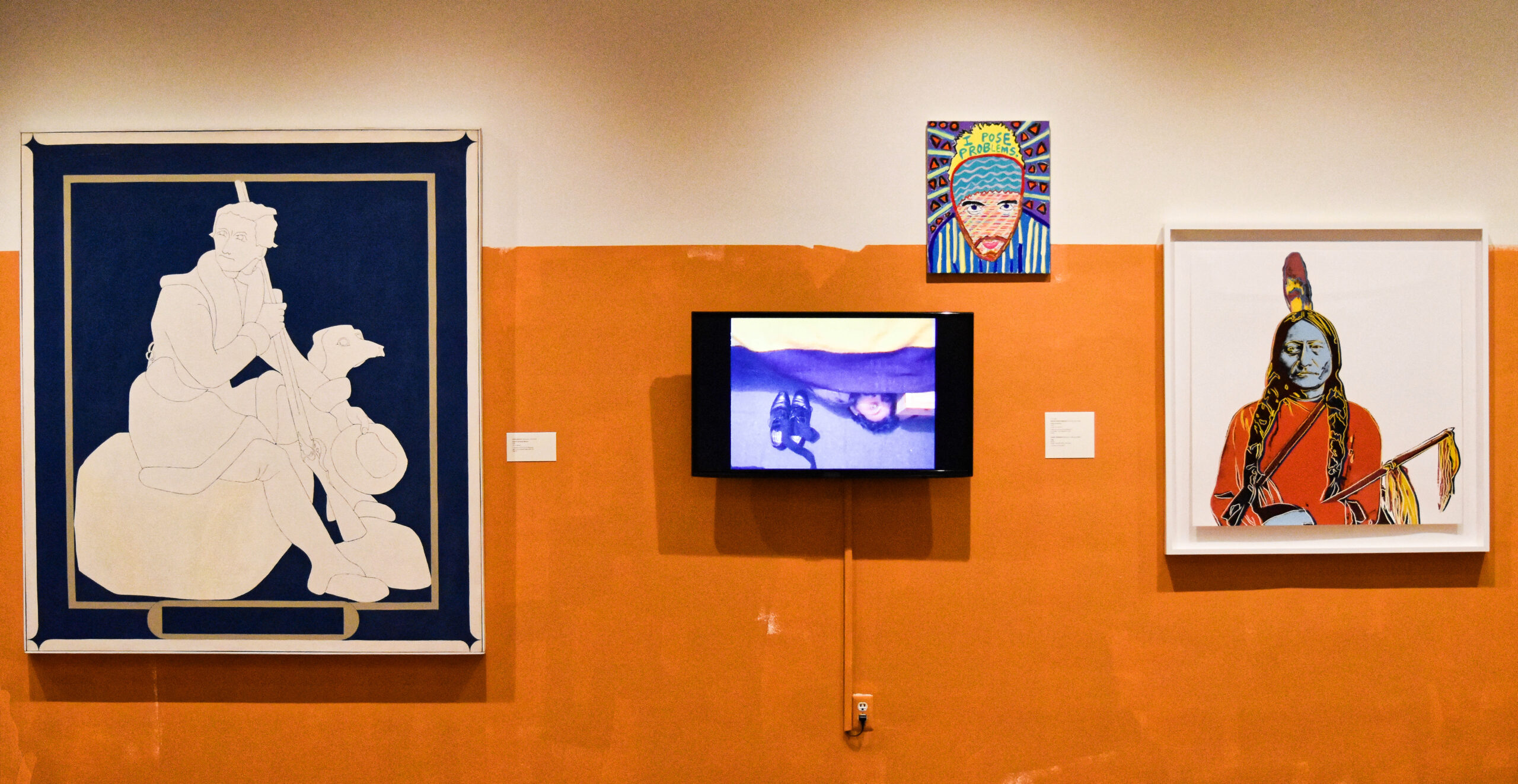“This is America*” at the University of Kentucky Art Museum makes its first and best move right at the start. As you walk into the gallery from the ticket counter, the first thing you see is a pairing of two artworks whose explosive juxtaposition becomes more and more highly charged as you look at it. On the left is Gilbert Stuart’s iconic portrait of George Washington (c. 1795), so central to the concept of American identity that you probably have a miniature copy of it – on a dollar bill – in your wallet right now. On the right is “George Floyd (Blackout Tuesday),” Michael Wong’s time-release recording of his iPad drawing of the black man killed on video by Minneapolis police this year, setting off social justice protests around the world.

It’s impossible not to draw an invisible line between these two Georges. It’s a timeline of sorts, jagged like an EKG, on which we see both how far we’ve come as a nation – which is to say, not very far at all in key respects – and how much farther we have to go. For all its high-flown rhetoric, the American experiment was riddled with contradictions from its inception. The Father of Our Country, so benevolent and wise in Stuart’s portrait, enslaved other humans for over half a century, calling for the abolition of slavery in his later years but never in his lifetime practicing what he preached. (Unlike most of the other founders, he did make arrangements for the emancipation of some of his slaves after his death.) And can anyone doubt that the legacy of slavery includes, on that jagged timeline, what happened to Floyd? As his face – currently rivaling Washington’s in familiarity and symbolic potency – slowly coalesces over and over in Wong’s drawing, we see in it the nation itself stuck in a loop, still engaged in the Sisyphean act of realizing the Pledge of Allegiance’s vision of “one nation, indivisible, with liberty and justice for all.”
These are the sort of thoughts you have while viewing “This is America*” (yes, the asterisk is intentional). Shrewdly curated by Museum Director Stuart Horodner, this exhibit packs a considerable aesthetic and political punch, with a mutually illuminating mix of works by nationally known and local artists. According to Horodner’s unsigned wall text, the exhibit was initially envisioned to coincide with the 2020 presidential election but took on additional layers of meaning in light of the protests that erupted worldwide in the wake of the Floyd killing. Dedicated to U.S. Rep. John Lewis, the civil rights leader who died in July, the show is a rare opportunity for a museum to respond to events in something like real time, using politically conscious artwork of the recent past to reflect the present and recontextualize the iconographies of earlier American art. This up-to-the-minute aspect of the show, by the way, is reflected in a gesture – the gallery walls have been roughly painted in a way that evokes urban streetscapes, painted-over graffiti and protest art – that may strike some viewers as too clever (or perhaps too half-hearted) for its own good. It’s subtle enough not to do any real harm, however, and effective enough to connect us, however subliminally, to the jarring events still unfolding just outside the pristine white walls of every museum and gallery in America.
Appropriately, much of the art – not all of it, more on that later – focuses on race, racism and the struggle for social justice. Just to the right of the Stuart/Wong pairing is Mike Howard’s massive acrylic painting, “Charlottesville A Crime Scene” (2017), a vivid depiction, almost in the style of graphic novels, of a white supremacist plowing his Dodge Challenger into a crowd of peaceful protesters. (This event, you’ll recall, was made doubly infamous by President Trump’s insistence on there being “very fine people on both sides” of an attempted, partly successful, massacre.) It hardly needs saying how relevant this event continues to be in this country, how long a shadow it still casts. Yes, this is America. Making your way along the gallery to the right, you find yourself confronting a magnificent trio of iconic pieces: Gordon Parks’ photograph “Invisible Man, Harlem, New York” (1952), Frank Weathers Long’s woodcut “John Henry” (1941), and David Alfaro Siqueiros’s lithograph “Dama negra” (“Black Woman,” 1935), all of which capture aspects, concrete and ineffable, of the black experience. These too are America, this and this and this.

Across the gallery on the facing wall is another striking lineup of works that Horodner has placed together, like the host of a formal dinner with assigned seats at the table, in lively, fruitful, perhaps heated dialogue. To consider John Wesley’s eerily vacant “Portrait of Daniel Boone” (1962) in the same field of vision with Andy Warhol’s “Cowboys and Indians (Sitting Bull)” (1986) is to traverse an art-historical Trail of Tears, the myth of American exceptionalism colliding with the reality (to borrow another Trump phrase, uttered in a different context) of American carnage. Two smaller works that separate Boone from Sitting Bull – “Flag” (2003), Bulgarian-American artist Daniel Bozhkov’s video of an immigrant answering citizenship questions, and “I Pose Problems” (2010) by the writer-turned-painter Wayne Koestenbaum, known for his literary explorations of LGBTQ identity – reinforce the show’s overall conception of a national chorus of multiple voices crying out, meekly or angrily or stoically, to be heard.

“This is America*,” like the country it seeks to define, is far from perfect, demographically speaking. Women’s voices are egregiously underrepresented in this chorus. Most galling is the fact that two of the best pieces in the show by artists of either gender – Barbara Kruger’s prophetic “We Will No Longer Be Seen And Not Heard” portfolio (1985) and Carolyn Young Hisel’s electrifying deathbed scene “Passage” (1987) – hang not in the main gallery but in an outer hallway next to the elevator. They deserved better. Then there’s the matter of the physical and thematic overstuffing of the show, which seems to want to include everything and the kitchen sink, too, including “Pieces of String Too Short to Save” (1998), Donald Lipski’s sledgehammer indictment of American wastefulness, and Joseph Peragine’s “Hand” (2010), a series of four oil paintings depicting hand-washing. The Peragine paintings now seem prescient in light of the coronavirus pandemic, among other things, but their cumulative effect is diluted by the puzzling decision to break them into two pairs hung on different walls.
On balance, however, “This is America*” (which continues through February 13) is a powerful dot-connecting mechanism, showing, as the best museum exhibits do, how works of art speak not only to us but to each other, and how we can benefit from eavesdropping on those conversations. We see Sheldon Tapley’s tranquil street scene “Midwestern Alley” (1987), for example, in a new way when it’s paired with Elliott Erwitt’s photograph “Segregated Water Fountains, North Carolina” (1950). There’s much to be gained, as well, from the non-hierarchical display of works by Kentucky artists – including Tapley, Hisel, John Lackey, Louis Zoellar Bickett, Frank X Walker and others – alongside some of the biggest names in American art, past and present. If the hairs on your forearms prickle at various points along the way as mine did, it’s a sign, I think, that (a) you’re alive and (b) this is an unusually fine art show. My advice is to go and see it.
Top Image: Sheldon Tapley, 1987, Midwestern Alley, pastel on Stonehenge paper. Courtesy of UK Art Museum.
“This is America*”, curated by Stuart Horodner at the University of Kentucky Art Museum, is on exhibit through February 13, 2021. More information is at https://finearts.uky.edu/art-museum.




